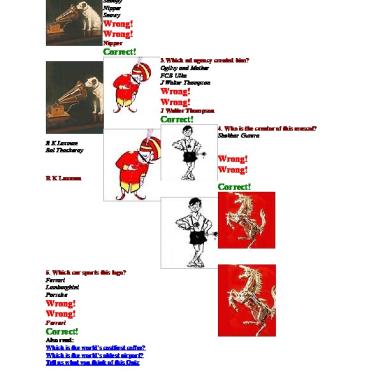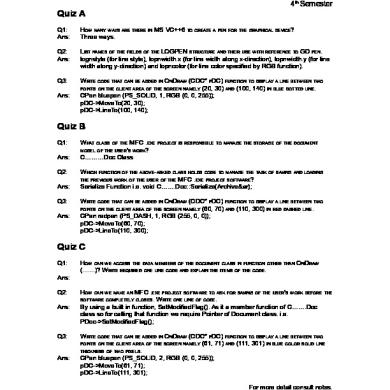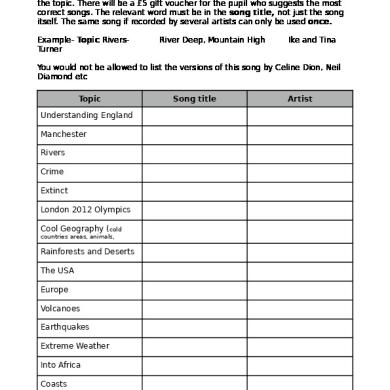(10)answers To Quiz 10.doc
This document was uploaded by user and they confirmed that they have the permission to share it. If you are author or own the copyright of this book, please report to us by using this DMCA report form. Report DMCA
Overview
Download & View (10)answers To Quiz 10.doc as PDF for free.
More details
- Words: 677
- Pages: 3
Answers to the questions in Quiz 10: 1. A bank has $10,000 in deposits, $3,200 in excess reserves, and $6,000 in loans. Find both the reserve ratio (RR) and the required reserve ratio (RRR). Show your calculations. Answer.
Total reserves = $10,000 – $6,000 = $4,000.
Reserve ratio (RR)=(total reserves ÷ deposits)×100 =(4,000 ÷ 10,000)×100 = 40%.
Required reserves = $10,000 – $3,200 – $6,000 = $800.
Required reserve ratio (RRR) = (required reserves ÷ deposits)×100 = (800 ÷ 10,000)×100 = 8%.
2. Explain how the central bank implements an expansionary and a contractionary monetary policy using the requirement reserves. Answer.
The central bank reduces the reserve requirement ratio (RRR). As such, there is more money available to commercial banks to loan out. In this case, money supply increases. We call this an expansionary monetary policy.
The central bank increases the reserve requirement ratio (RRR). As such, there is less money available to commercial banks to loan out. In this case, money supply decreases. We call this a contractionary monetary policy.
3. List the 3 functions of money. Answer. Money has 3 functions:
Money serves as a medium of exchange because it is used to purchase goods and services.
Money serves as a unit of account because it is used as the yardstick to post prices and record debt.
Money serves as a store of value because it is used to transfer purchasing power from the present to the future.
1
4. What is the definition of liquidity? Answer.
Definition of liquidity: the ease with which an asset can be converted into cash quickly at little cost.
As such, the narrow definition of money (M1) is more liquid than the broad definition of money (M2).
5. If the reserve ratio is 100 percent, depositing $500 of paper money in a bank will increase the money supply by how much? Show your calculations. Answer. Reserve ratio (RR) = 100% means that money multiplier (MM) = 1. This means that the $500 deposit does not multiply and therefore money supply stays the same.
6. Explain (i) how commercial banks react when the central bank increases the discount rate, and (ii) what happens to the reserve ratio, money multiplier, and money supply. Answer.
When the central bank increases the discount rate, the cost of borrowing (from the central bank) for the commercial banks increases.
Thus, commercial banks tend to keep more excess reserves (so that they don’t have to go to the central bank to borrow money at a high rate).
This increases the reserve ratio, reduces the money multiplier, and reduces the money supply.
7. Explain how the central bank implements an expansionary and a contractionary monetary policy using the open market operation. Answer.
The central bank buys back government bonds from the public in exchange for money (which can be printed). In this case, money supply increases. We call this an expansionary monetary policy.
The central bank sells government bonds to the public in exchange for money. In this case, money supply decreases. We call this a contractionary monetary policy.
2
8. Give 2 reasons why the central bank cannot 100% control money supply. Answer. The central bank controls money supply to a very large extent but not completely. This is because money supply is influenced:
by the behavior of the public in holding currency, and
by the behavior of commercial banks in holding excess reserves.
9. Write out the formula that defines the narrow definition of money. Answer. The narrow definition of money (M1) is currency in circulation (CC) plus demand deposits (DD). That is,
M1 = CC + DD
10. List the three tools available to the central bank to control money supply. Which tool is most often used? Answer. By implementing monetary policy, the central bank controls money supply using the following three tools:
the open market operation (OMO), which is most often used.
the requirement reserve ratio (RRR), and
the discount rate.
3
Total reserves = $10,000 – $6,000 = $4,000.
Reserve ratio (RR)=(total reserves ÷ deposits)×100 =(4,000 ÷ 10,000)×100 = 40%.
Required reserves = $10,000 – $3,200 – $6,000 = $800.
Required reserve ratio (RRR) = (required reserves ÷ deposits)×100 = (800 ÷ 10,000)×100 = 8%.
2. Explain how the central bank implements an expansionary and a contractionary monetary policy using the requirement reserves. Answer.
The central bank reduces the reserve requirement ratio (RRR). As such, there is more money available to commercial banks to loan out. In this case, money supply increases. We call this an expansionary monetary policy.
The central bank increases the reserve requirement ratio (RRR). As such, there is less money available to commercial banks to loan out. In this case, money supply decreases. We call this a contractionary monetary policy.
3. List the 3 functions of money. Answer. Money has 3 functions:
Money serves as a medium of exchange because it is used to purchase goods and services.
Money serves as a unit of account because it is used as the yardstick to post prices and record debt.
Money serves as a store of value because it is used to transfer purchasing power from the present to the future.
1
4. What is the definition of liquidity? Answer.
Definition of liquidity: the ease with which an asset can be converted into cash quickly at little cost.
As such, the narrow definition of money (M1) is more liquid than the broad definition of money (M2).
5. If the reserve ratio is 100 percent, depositing $500 of paper money in a bank will increase the money supply by how much? Show your calculations. Answer. Reserve ratio (RR) = 100% means that money multiplier (MM) = 1. This means that the $500 deposit does not multiply and therefore money supply stays the same.
6. Explain (i) how commercial banks react when the central bank increases the discount rate, and (ii) what happens to the reserve ratio, money multiplier, and money supply. Answer.
When the central bank increases the discount rate, the cost of borrowing (from the central bank) for the commercial banks increases.
Thus, commercial banks tend to keep more excess reserves (so that they don’t have to go to the central bank to borrow money at a high rate).
This increases the reserve ratio, reduces the money multiplier, and reduces the money supply.
7. Explain how the central bank implements an expansionary and a contractionary monetary policy using the open market operation. Answer.
The central bank buys back government bonds from the public in exchange for money (which can be printed). In this case, money supply increases. We call this an expansionary monetary policy.
The central bank sells government bonds to the public in exchange for money. In this case, money supply decreases. We call this a contractionary monetary policy.
2
8. Give 2 reasons why the central bank cannot 100% control money supply. Answer. The central bank controls money supply to a very large extent but not completely. This is because money supply is influenced:
by the behavior of the public in holding currency, and
by the behavior of commercial banks in holding excess reserves.
9. Write out the formula that defines the narrow definition of money. Answer. The narrow definition of money (M1) is currency in circulation (CC) plus demand deposits (DD). That is,
M1 = CC + DD
10. List the three tools available to the central bank to control money supply. Which tool is most often used? Answer. By implementing monetary policy, the central bank controls money supply using the following three tools:
the open market operation (OMO), which is most often used.
the requirement reserve ratio (RRR), and
the discount rate.
3
Related Documents

Answers To Quiz 2
December 2019 22
Quiz
November 2019 39
Quiz
May 2020 34
Quiz
November 2019 35
Quiz
May 2020 33
Quiz
October 2019 45More Documents from ""

(12)answers To Quiz 12.doc
November 2019 14
(9)answers To Quiz 9.doc
November 2019 19
(13)answers To Quiz 13.doc
November 2019 16
(11)answers To Quiz 11.docx
November 2019 13
(10)answers To Quiz 10.doc
November 2019 13